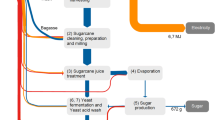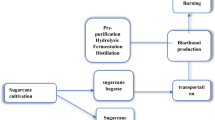Abstract
First-generation bioethanol production from fermentation is a widely applied technology, with the United States of America and Brazil being the global leaders. However, several concerns regarding the widespread production of biofuels have arisen, particularly its environmental impacts. To address this issue, this study details the environmental impacts of the production of fist-generation bioethanol from sweet potato (Ipomoea batatas L.) in a pilot scale facility, using the Life Cycle Assessment (LCA) methodology. Cultivation and transformation of sweet potato into bioethanol are considered in the system boundaries. The background data for the life cycle inventory were mainly obtained from the Ecoinvent 3.1 database and considered both literature and field data. The SimaPro software was used to perform the impact assessment considering the CML IA baseline 3.02 method. Three different agricultural waste scenarios are also considered and compared to evaluate the best-case scenarios. In addition, sensitivity analysis and comparison with other similar studies are thoroughly explored. Overall, the analyzed production system has lower impacts than indicated in similar studies, but considering its pilot scale, improvement of its environmental impacts is necessary, which might be addressed with larger scale and centralized support systems regarding transportation and other aspects. Based on the results, several recommendations to decrease environmental impacts are also listed.



Similar content being viewed by others
References
Acheampong et al (2017) In pursuit of sustainable development goal (SDG) number 7: will biofuels be reliable? Renew Sust Energ Rev 75:927–937. https://doi.org/10.1016/j.rser.2016.11.074
Arapoglou et al (2010) Ethanol production from potato peel waste (PPW). Waste Manag 30:1898–1902. https://doi.org/10.1016/j.wasman.2010.04.017
Bennertz, Rip (2018) The evolving Brazilian automotive-energy infrastructure: entanglements of national developmentalism, sugar and ethanol production, automobility and gasoline. Energy Research & Social Science 41:109–117. https://doi.org/10.1016/j.erss.2018.04.022
Brown, Sovacool BK (2011) Brazil’s proalcohol program and promotion offlex-fuel vehicles, In: MIT Press (Ed.), Climate change and global energy security: technology and policy options, Cambridge, pp. 260–274
Clavreul et al (2012) Quantifying uncertainty in LCA-modelling of waste management systems. Waste Manag 32:2482–2495. https://doi.org/10.1016/j.wasman.2012.07.008
CML-IE (2016) (Institute of Environmental Sciences/Department of Industrial Ecology). CML-IA Characterisation Factors. Retrieved from: http://cml.leiden.edu/software/data-cmlia.html Access date: 07.10.17
Council Directive (EU) 2015/652. Council Directive (EU) 2015/652 of 20 April 2015 laying down calculation methods and reporting requirements pursuant to Directive 98/70/EC of the European Parliament and of the Council relating to the quality of petrol and diesel fuels. European Union
Directive 2009/28/EC, Directive 2009/28/EC of the European Parliament and of the Council of 23 April 2009 on the promotion of the use of energy from renewable sources and amending and subsequently repealing Directives 2001/77/EC and 2003/30/EC (Text with EEA relevance) Official Journal of the European Union, pp. 16–62
Duffield et al. (2015) U.S. ethanol: an examination of policy, production, use, distribution, and market interactions. 87
Dunn et al (2012) Energy consumption and greenhouse gas emissions from enzyme and yeast manufacture for corn and cellulosic ethanol production. Biotechnol Lett 34:2259–2263. https://doi.org/10.1007/s10529-012-1057-6
EPA (Unites States Environmental Protection Agency) (1994) Emission Factor Documentation for AP-42: Section 9.2.2 - Section 9.2.2. EPA, USA
EPE (Empresa de Pesquisa Energética) (2017) Brazilian Energy Balance Brazil
FAOSTAT (Food and Agriculture Organization Corporate Statistical Database) (2017) Crops. Retrieved from: http://www.fao.org/faostat/en/#home. Access date: 07.09.17
Feedpedia (Animal Feed Resources Information System) (2017) Wheat distillers grain. Retrieved from: https://www.feedipedia.org/node/4265. Access date: 08.09.17
Hall et al (2009) Brazilian biofuels and social exclusion: established and concentrated ethanol versus emerging and dispersed biodiesel. J Clean Prod 17:S77–S85. https://doi.org/10.1016/j.jclepro.2009.01.003
Heijungs, Kleijn (2001) Numerical approaches towards life cycle interpretation—five examples. Int J Life Cycle Assess 6:141–148. https://doi.org/10.1065/Ica2000.12.045
Heijungs et al (2005) Numerical approaches to life cycle interpretation—the case of the Ecoinvent’96 database (10 pp). Int J Life Cycle Assess 10:103–112. https://doi.org/10.1065/lca2004.06.161
IEA (International Energy Agency) (2016) World Energy Outlook 2016. OECD/IEA, France
IPCC, 2006. N2O emissions from managed soils, and co2 emissions from lime and urea application, 2006 IPCC Guidelines for National Greenhouse Gas Inventories
ISO 14040 (2006) (International Organization for Standardization). Environmental management—life cycle assessment—principles and framework. ISO 14040:2006 ISO 14040:2006
La Rovere et al (2011) Biofuels and sustainable energy development in Brazil. World Dev 39:1026–1036. https://doi.org/10.1016/j.worlddev.2010.01.004
Lareo et al (2013) Evaluation of sweet potato for fuel bioethanol production: hydrolysis and fermentation. SpringerPlus 2:493. https://doi.org/10.1186/2193-1801-2-493
Lehtonen (2011) Social sustainability of the Brazilian bioethanol: power relations in a centre-periphery perspective. Biomass Bioenergy 35:2425–2434. https://doi.org/10.1016/j.biombioe.2009.05.027
Lima et al (2000) Solo e aptidão das terras do Estado de Tocantins. EMPRAPA, Brazil
Milà i Canals et al (2013) Land use impact assessment of margarine. Int J Life Cycle Assess 18:1265–1277. https://doi.org/10.1007/s11367-012-0380-4
Muñoz et al (2014) Life cycle assessment of bio-based ethanol produced from different agricultural feedstocks. Int J Life Cycle Assess 19:109–119. https://doi.org/10.1007/s11367-013-0613-1
Nemecek T, Kägi T (2007) Life cycle inventories of agricultural production systems. E. Centre. Zürick and Dübendorf, Ecoinvent Centre
Nielsen et al (2007) Cradle-to-gate environmental assessment of enzyme products produced industrially in Denmark by Novozymes A/S. Int J Life Cycle Assess 12:432–438. https://doi.org/10.1065/lca2006.08.265.1
Oliveira et al (2007) Produção da batata-doce adubada com esterco bovino e biofertilizante. Ciênc Agrotecnol 31:1722–1728. https://doi.org/10.1590/S1413-70542007000600018
Pianosi et al (2016) Sensitivity analysis of environmental models: a systematic review with practical workflow. Environ Model Softw 79:214–232. https://doi.org/10.1016/j.envsoft.2016.02.008
Rathnayake et al (2018) Process simulation based life cycle assessment for bioethanol production from cassava, cane molasses, and rice straw. J Clean Prod 190:24–35. https://doi.org/10.1016/j.jclepro.2018.04.152
RFA (Renewable Fuels Association) (2015) 2016 Ethanol industry outlook. USA
Rosenbaum et al (2015) The Glasgow consensus on the delineation between pesticide emission inventory and impact assessment for LCA. Int J Life Cycle Assess 20:765–776. https://doi.org/10.1007/s11367-015-0871-1
Rosillo-Calle, et al. (2008) The biomass assessment handbook. Earthscan, United Kigndom, p. 296
Saltelli et al (2006) Sensitivity analysis practices: strategies for model-based inference. Reliab Eng Syst Saf 91:1109–1125. https://doi.org/10.1016/j.ress.2005.11.014
Silva et al (2008) Batata-doce (Ipomoea batatas). Empresa Brasileira de Pesquisa Agropecuária (EMPRAPA), Brazil
Silva, et al (1995) Cultivo da batata-doce (Ipomoea batatas (L.) Lam). EMBRAPA-CNPH. Instruções técnicas da Embrapa Hortalicas, 7Empresa Brasileira de Pesquisa Agropecuária (EMPRAPA), Brasília
Silveira et al (2008) A cultura da batata-doce como fonte de matéria prima para o etanol. Universidade Federal do Tocantis/Ministério da Ciência e Tecnologia, Palmas
Sovacool (2016) How long will it take? Conceptualizing the temporal dynamics of energy transitions. Energy Research & Social Science 13:202–215. https://doi.org/10.1016/j.erss.2015.12.020
Stattman et al (2013) Governing biofuels in Brazil: a comparison of ethanol and biodiesel policies. Energy Policy 61:22–30. https://doi.org/10.1016/j.enpol.2013.06.005
Swain et al (2013) Bioethanol production from sweet potato (Ipomoea batatas L.) flour using co-culture of Trichoderma sp. and Saccharomyces cerevisiae in solid-state fermentation. Braz Arch Biol Technol 56:171–179. https://doi.org/10.1590/S1516-89132013000200002
Thumé et al (2013) Níveis críticos foliares de nutrientes de três cultivares de batata-doce, selecionados para a produção de etanol. Revista Ceres 60:863–875. https://doi.org/10.1590/S0034-737X2013000600015
Unal, Alibas (2007) Agricultural residues as biomass energy. Energy Sources, Part B: Economics, Planning, and Policy 2:123–140. https://doi.org/10.1080/15567240600629401
Virgínio e Silva et al (2017) Integrated production of biodiesel and bioethanol from sweet potato. Renew Energy 124:114–120. https://doi.org/10.1016/j.renene.2017.07.052
Wang et al (2016) An environmentally friendly and productive process for bioethanol production from potato waste. Biotechnol Biofuels 9:50. https://doi.org/10.1186/s13068-016-0464-7
Wang et al (2013) Life-cycle energy efficiency and environmental impacts of bioethanol production from sweet potato. Bioresour Technol 133:285–292. https://doi.org/10.1016/j.biortech.2013.01.067
Wernet et al (2016) The ecoinvent database version 3 (part I): overview and methodology. Int J Life Cycle Assess 21:1218–1230. https://doi.org/10.1007/s11367-016-1087-8
Zhang et al (2017) Life cycle energy efficiency and environmental impact assessment of bioethanol production from sweet potato based on different production modes. PLoS One 12:e0180685. https://doi.org/10.1371/journal.pone.0180685
Author information
Authors and Affiliations
Corresponding author
Electronic supplementary material
ESM 1
(DOCX 25.5 kb)
Rights and permissions
About this article
Cite this article
Costa, D., Jesus, J., Virgínio e Silva, J. et al. Life Cycle Assessment of Bioethanol Production from Sweet Potato (Ipomoea batatas L.) in an Experimental Plant. Bioenerg. Res. 11, 715–725 (2018). https://doi.org/10.1007/s12155-018-9932-1
Published:
Issue Date:
DOI: https://doi.org/10.1007/s12155-018-9932-1




